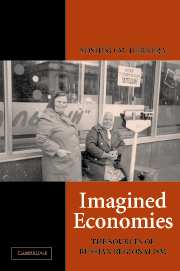Book contents
- Frontmatter
- Contents
- List of Tables
- List of Figures and Maps
- List of Acronyms
- Note on Transliteration
- Acknowledgments
- Imagined Economies
- Introduction
- 1 Regionalism in the Russian Federation: Theories and Evidence
- 2 Imagined Economies: Constructivist Political Economy and Nationalism
- 3 Breaking the Soviet Doxa: Perestroika, Rasstroika, and the Evolution of Regionalism
- 4 To Each His Own: The Development of Heterogeneous Regional Understandings and Interests in Russia
- 5 Imagined Economies in Samara and Sverdlovsk: Differences in Regional Understandings of the Economy
- 6 Regional Understandings of the Economy and Sovereignty: The Economic Basis of the Movement for a Urals Republic
- 7 Regional Understandings, Institutional Context, and the Development of the Movement for a Urals Republic
- Conclusion
- Appendix Tables
- Index
- Cambridge Cultural Social Studies
4 - To Each His Own: The Development of Heterogeneous Regional Understandings and Interests in Russia
Published online by Cambridge University Press: 22 September 2009
- Frontmatter
- Contents
- List of Tables
- List of Figures and Maps
- List of Acronyms
- Note on Transliteration
- Acknowledgments
- Imagined Economies
- Introduction
- 1 Regionalism in the Russian Federation: Theories and Evidence
- 2 Imagined Economies: Constructivist Political Economy and Nationalism
- 3 Breaking the Soviet Doxa: Perestroika, Rasstroika, and the Evolution of Regionalism
- 4 To Each His Own: The Development of Heterogeneous Regional Understandings and Interests in Russia
- 5 Imagined Economies in Samara and Sverdlovsk: Differences in Regional Understandings of the Economy
- 6 Regional Understandings of the Economy and Sovereignty: The Economic Basis of the Movement for a Urals Republic
- 7 Regional Understandings, Institutional Context, and the Development of the Movement for a Urals Republic
- Conclusion
- Appendix Tables
- Index
- Cambridge Cultural Social Studies
Summary
The first Russian Republic, which began in the fall of 1991 and lasted until December 1993, was outside the organizing framework of the Soviet doxa. Instead, this was a period of contestation over power and the system of authority that would structure political and economic relations in the Russian Federation. Politically, it was a game of musical chairs: All the rules and paths to power had been upset, and no one knew which institution would turn out to be the relevant one. The Federation Treaty and the Constitution were works-in-progress, and there were many organizational choices facing political actors including multiple seats of authority in the region. But, who knew which chair would be left when the music stopped – would it be the executive or the legislature, the center or the regions? On the economic side, the de facto decentralization of economic resources that began under perestroika and accelerated with the decline of the CPSU represented the transformation from Soviet principles of redistribution to a Hobbesian every-region-for-itself state of anarchy that exacerbated regional inequality. During this period, regions came to appreciate the new opportunities that had opened up to them and the urgency of making choices; consequently, at this time they developed a sense of post-Soviet regional economic interests.
In this chapter, I analyze the post-doxa period of the first Russian Republic from the late fall of 1991 to December 1993 as a space for the development of new, differentiated, regional understandings, that is, heterogeneous conceptualizations and solutions to problems.
- Type
- Chapter
- Information
- Imagined EconomiesThe Sources of Russian Regionalism, pp. 143 - 167Publisher: Cambridge University PressPrint publication year: 2004



